CBSE Class 12 Biology Answer Key 2023: Lakhs of students appeared today, on Thursday, March 16, 2023, for the CBSE Class 12 Biology board exam 2023 from 10.30 AM to 1.30 AM. Biology is one of the most major examinations for the students in the Science stream and students had varied experiences during the preparation for the exam and during the examination itself. In this article, students will be able to check the CBSE Class 12 Biology 2023 Answer Key, prepared by subject experts, for all sets. Since the Biology exam scores are very important for students - especially for students planning to pursue medical, healthcare and allied fields at university-level - the answer key will help ease down your post-exam stress about correct and incorrect answers.
Class 12 Biology Question Paper and Answer Key: Key Highlights
| Board | |
| Subject | Biology |
| Exam Date | 16 March 2023 |
| Marking Scheme Status | Not Released |
| Official Website | cbse.gov.in |
CBSE Class 12 Biology Paper Question Paper and Answer Key 2023
The Central Board of Secondary Education hasn’t released either the question papers or the 2023 class 12 Biology answer key yet.
Our subject experts have prepared the CBSE Class 12 Biology answer key 2023 and you can get the same below.
Related:
CBSE Class 12 Biology 2023 Answer Key
Section A
1 At what stage during evolution did humans use hides to protect their bodies and buried their dead?
A Homo habilis
B Neanderthal man
C Java man
D Homo erectus
Ans: B Neanderthal man
2
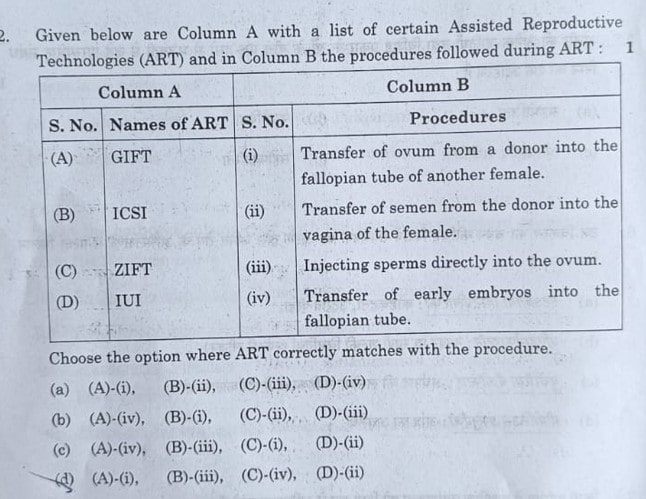
Ans: d A - i, B - iii, C - iv, D - ii
3 The decrease in the T-lymphocytes count in human blood will result in:
(a) Decrease in antigens
(b) Decrease in antibodies
(c) Increase in antibodies
(d) Increase in antigens
Ans: (b) Decrease in antibodies
4 Given below is a sequence of bases in mRNA of a bacterial cell. Identify the amino acid that would be incorporated at codon position 3 and codon position 5 during the process of its translation.
3' AUCAGGUUUGUGAUGGUACGA 5'
(a) Phenylalanine, Methionine
(b) Cysteine, Glycine
(c) Alanine, Proline
(d) Serine, Valine
Ans: (a) Phenylalanine, Methionine
5 A Tight one-to-one relationship between many species of fig tree and certain wasps is an example of
(a) Commensalism
(b) Parasitism
(c) Amensalism
(d) Mutualism
Ans: (d) Mutualism
6 Select the pathogen mismatched with the symptoms of disease caused by it from the list given below
(a) Entamoeba histolytica : Constipation, abdominal pain.
(b) Epidermophyton : Dry scaly lesions on nail
(c) Wuchereria bancrofti : Chronic inflammation of lymphatic vessels of lower limb
(d) Haemophilus influenzae : Blockage of the intestinal passage.
Ans: (d) Haemophilus influenzae : Blockage of the intestinal passage.
7 The primary productivity in an ecosystem is expressed as :
(a) gm-2 yr-1
(b) gm-2 yr
(b) Kcal m-2 yr-1
(d) K cal m-2
Ans: (d) K cal m-2
8 Given below is the restriction site of a restriction endonuclease Pst-I and the cleavage sites on a DNA molecule. 
Choose the option that gives the correct resultant fragments by the action of the enzyme Pst-I. 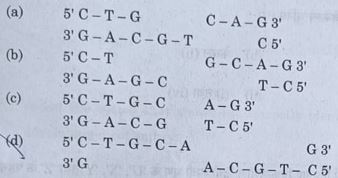
Ans: d
9 The IUCN Red Data List (2004) in the last 500 years documents the extinction of nearly 784 species including
(a) 330 invertebrates
(b) 338 invertebrates
(c) 359 invertebrates
(d) 362 invertebrates
Ans: (c) 359 invertebrates
10 Given below are the list of the commercially important products and their source organisms. Select the option that gives the correct matches.
| List A | List B |
| Bioactive Products | Microbes (Source Organism) |
| (A) Cyclosporin A | (i) Streptococcus |
| (B) Statins | (ii) Tricoderma polysporum |
| (C) Streptokinase | (iii) Penicillium notatum |
| (D) Penicillin | (iv) Monascus purpureus |
Options :
(a) (A)-(i), (B) -(ii), (C)-(iii), (D)-(iv)
(b) (A)-(iii), (B)-(iv), (C)-(ii), (D)-(i)
(c) (A)-(iv), (B)-(iii), (C)-(ii), (D)-(i)
(d) (A)-(ii), (B)-(iv), (C)-(i), (D)-(iii)
Ans: (d) (A)-(ii), (B)-(iv), (C)-(i), (D)-(iii)
11 Important attributes belonging to a population but not to an individual are
(i) Birth rate and death rate
(ii) Male and female
(iii) Birth and death
(iv) Sex-ratio
Select the correct option from the given options :
(a) (i) only
(b) (ii) only
(c) (ii) and (iii)
(d) (i) and (iv)
Ans: (d) (i) and (iv)
12 Select the option that shows the correctly identified 'U', X, Y and Z in a developing dicot embryo.

(a) X-Plumule (2n), Y Suspensor (n), Z Cotyledon (2n), U- Radicle (2n).
(b) X-Plumule (2n), Y- Suspensor (2n), Z = Radicle (2n), U - Cotyledon (2n).
(c) X-Suspensor (2n), Y Cotyledon (2n), Z- Radicle (2n), U- Plumule (2n).
(d) X-Cotyledon (2n), Y- Radicle (n), Z-Plumule (n), U-Suspensor (n).
Answer: (d) X-Cotyledon (2n), Y- Radicle (n), Z-Plumule (n), U-Suspensor (n).
Question Nos. 13 to 16 consists of two statements, Assertion (A) and Reason
(R). Answer these questions selecting the appropriate option given below:
(a) Both (A) and (R) are true and (R) is the correct explanation of (A).
(b) Both (A) and (R) are true, but (R) is not the correct explanation of (A).
(c) (A) is true, but (R) is false.
(d) (A) is false, but (R) is true.
13 Assertion (A): Determining the sex of an unborn child followed by MTP is an illegal practice.
Reason (R): Amniocentesis is a practice to test the presence of genetic disorders also.
Answer: (d)
14 Assertion (A): Synthetic oligonucleotide polymers are used during Annealing in a PCR. Reason (R): The primers bind to the double stranded DNA at their complementary regions.
Answer: (a)
15 Assertion (A): Decomposition process is slower if detritus is rich in lignin and cutin.
Reason (R): Decomposition is largely an oxygen requiring process.
Answer: (b)
16 Assertion (A): In Thalassemia an abnormal myoglobin chain is synthesized due to a gene defect.
Reason (R) α-Thalassemia is controlled by genes HBA1 and HBA2 on chromosome 16.
Answer: (d)
Section B
Question 17: The graph given below shows the number of primordial follicles per ovary in women at different ages. Study the graph and answer the questions that follow.
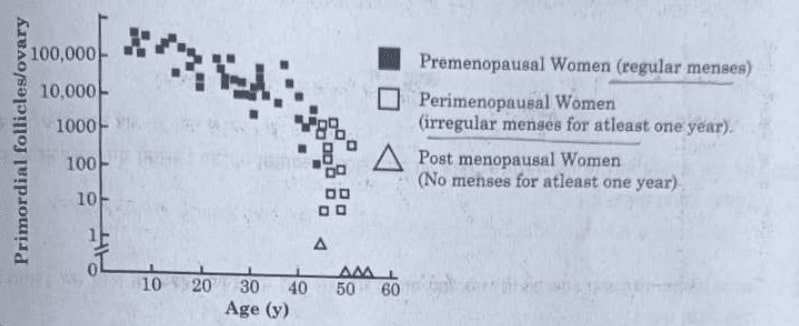
- What is the average age of the women at the onset of menopause?
- At what age are maximum primordial follicles present in the ovary, according to the given graph?
Ans:
- 50 years
- 10 years
Question 18: "Cattle and goats do not browse the Calotropis plant." Justify the statement giving reasons.
Ans: Organisms to survive in the complex food web have evolved characters to support their living and prevent them from predators. One of such example is Calotropis. Calotropis plant also known as milkweed produce a chemical compound cardiac glycoside that affect the mammalian heart. It is the defence mechanism in Calotropis plant to keep cattle stay away from it. This is the reason cattle and goats do not feed/browse on this plant.
Question 19: By using Punnett square depict the genotypes and phenotypes of test crosses (where green pod colour (G) is dominant over yellow pod colour (g)) in Garden pea with unknown genotype.
Ans: Test cross is a type of genetic cross which is used to know the genotype of an unknown organism. In this, unknown parent is crossed with a homozygous recessive parent.
Given:
Dominant allele: G
Dominant trait: Green pod color
Recessive allele: g
Recessive trait: yellow pod color
Condition 1:
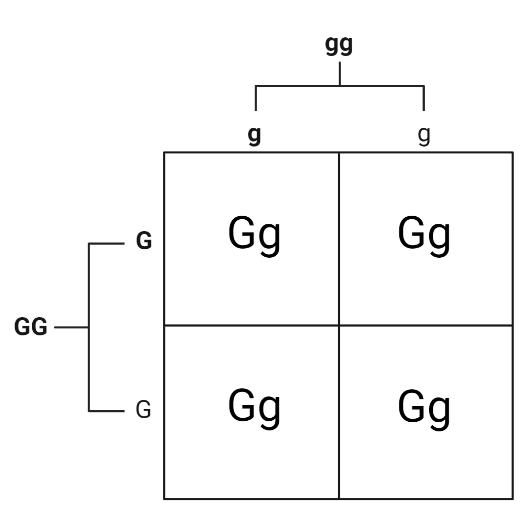
Genotypic ratio: 100% heterozygous dominant i.e, 1:0 ratio
Phenotypic ratio: all green
Conculsion: Unknown is homozygous dominant
Condition 2:
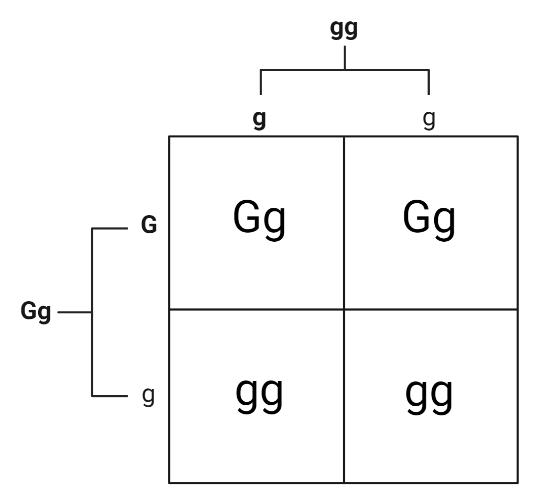
Genotypic ratio: 50% heterozygous dominant and 50% heterozygous dominant i.e, 1:1 ratio
Phenotypic ratio: 50% Green: 50% Yellow
Conculsion: Unknown is heterozygous dominant
Condition 3:
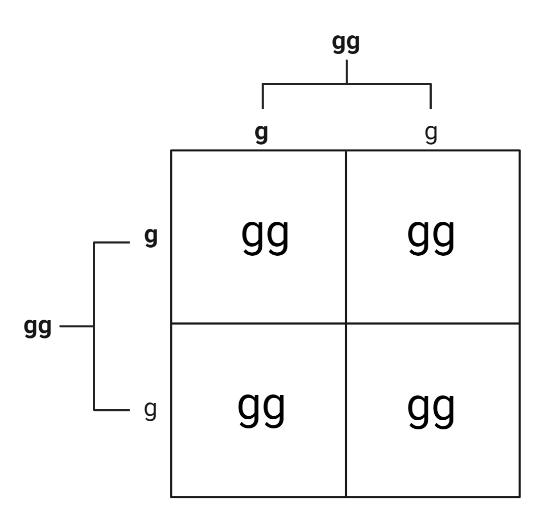
Genotypic ratio: 100% recessive i.e, 1:0 ratio
Phenotypic ratio: all yellow
Conculsion: Unknown is homozygous recessive
Question 20:
a)
(i) Give an example of a genus of virus used as narrow spectrum insecticidal biocontrol agent.
(ii) How does its use serve as an aid in overall integrated pest management programme?
OR
b) Why a malignant tumour considered to be more damaging than a benign tumour? Explain.
Answer:
a)
i) Nucleopolyhedrovirus
ii) Baculoviruses are the viruses belong the genous These viruses attack the arthropods/insects. These viruses are excellent species specific effective narrow spectrum insecticidal biocontrol agent. This is especially important when treating an environmentally sensitive area or conserving beneficial insects to support an overall integrated pest management (IPM) programme.
b)
Tumours are the cellular mass that develop inside the body due to accumulation of cells or their over growth. These are divided into categories of benign and malignant tumours. Benign tumours are less harmful as compared to malignant tumours. It is because, malignant tumours have malignant property i.e, the cells of malignant tumours can detach from their main site and spread in other parts of the body. Thus, malignant tumours spread easily in the body. This leads to chances of cancer spread in the patient with malignant tumours.
Question 21:
(a) Write the scientific name of the source organism of the themostable DNA polymerase used in PCR.
(b) State the advantage of using Thermostable DNA polymerase.
Answer:
a) Thermus aquaticus
b) Thermostable polymerase (Taq polymerase) is used in the PCR due to their advantage to remain active at very high temperatures. Unlike other polymerases, Taq polymerase do not get dentaure in the process of PCR thus, effectively perform the task of DNA strand polymeriozation even at 94-95⁰C temperature.
Section C
Question 22: Name and explain a surgical contraceptive method that can be adopted by the male partner of a couple.
Answer:
The surgical contraceptive method adopted by the male partner is vasectomy.
In vasectomy a surgical expert cut the vas deferens and ties the ends to stop the transport of sperms from the epididymis to the ejaculatory duct. Thus, it ensures the absence of sperm in the male ejaculation to prevent unwanted pregnancies. This procedure is performed on both the vas deferens. It is an irreversible procedure thus, if the male partner wants to plan a baby with his partner can surgically eliminate this restriction.
Question 23: Human Genome Project (HGP) was a mega project launched in the year 1990 with some important goals.
(a) Enlist any four prime goals of HGP.
(b) Name any one common non-human animal model organism which has also been sequenced thereafter.
Answer:
a) (i) Identify all the approximately 20,000-25,000 genes in human DNA
(ii) Determine the sequences of the 3 billion chemical base pairs that make up human DNA
(iii) Store this information in databases
(iv) Improve tools for data analysis
b) Caenorhabditis elegans (a free living non-pathogenic nematode)
Question 24: Industrial melanism in England after 1850 is an excellent example of Natural selection. Explain how?
Answer:
Industrial melanism in England after 1850 is an excellent example of Natural selection. It is because, before industrialization the air quality of England was good due to which lichens were able to grow on tree barks. Lichens were white in color. Hence, moths living on tree bark evolved with time to have a more white population due to less melanin production. This reduced the number of black moths in the population. This was an adaptation to hide from predators.
With time as industrialization grew the air quality reduced. This eliminated the lichens from the region. Now the dark brown to black color of tree bark was exposed. Due to this, the moth population evolved to have more melanin giving them black color. This reduced the number of white moths in the population. This was an adaptation to hide from predators’ attacks.
In short, evolving with the situation gave moths’ population a benefit due to natural selection.
Question 25: One of the major approaches of crop improvement programme is Artificial Hybridisation. Explain the steps involved in making sure that only the desired pollen grain pollinate the stigma of a bisexual flower by a plant breeder.
Answer:
When the desired pollen grains are used for pollination and fertilization to get desired progeny, is called artificial hybridisation.
Steps of artificial hybridisation:
- Emasculation: In this step, the anthers (male part) are removed from a bisexual flower to avoid unwanted fertilization from the anthers of the same flower. Unisexual flowers do not require this step.
- Bagging: In this, the flowers are covered with a bag to avoid landing of unwanted pollen grains on the stigma. The bagging is done till the flower attains receptivity.
- Pollination: Pollens with desired traits are dusted onto the flower after the flower is ready to receive the pollens.
Question 26: (a) "Plasmodium protozoan needs both a mosquito and a human host for its continuity." Explain.
OR
(b) We all must work towards maintaining good health because health is wealth'. Enlist any six ways of achieving good health.
Answer:
a) Female Anopheles mosquitoes are the primary host for Plasmodium protozoan and human beings are the secondary host for the same. This is the reason the Plasmodium protozoan both, mosquitoes and human hosts for its continuity. The detailed life cycle of Plasmodium is given below.
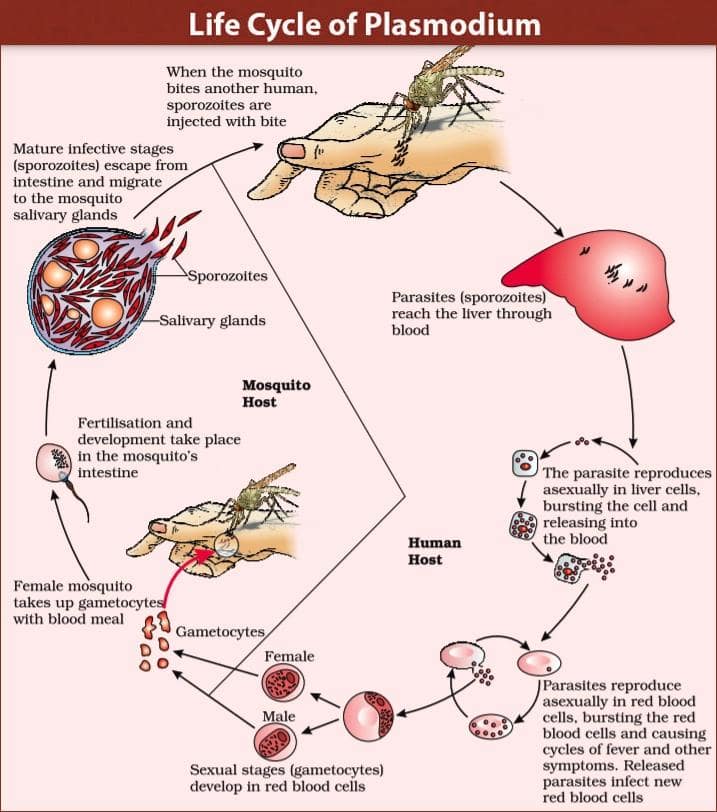
b)
- Eat healthy
- Regular exercise
- Personal Hygiene
- Proper waste disposal
- Keep the surroundings clean
- Do no consume harmful substances like alcohol and drugs.
Question 27: On spraying Bacillus thuringiensis on an infected cotton crop field the pests are killed by the toxin, however the toxin although produced by the bacteria does not affect it. Explain giving reason.
Answer:
Some strains of Bacillus thuringiensis produce proteins that kill certain insects such as armyworm, beetles, flies, and mosquitoes. B. thuringiensis forms crystals of protein during their growth that comprise of a toxic insecticidal protein. The Bt toxin protein exist as inactive protoxins but once an insect ingest the inactive toxin, it is converted into an active form of toxin due to the alkaline pH of the gut which solubilise the crystals. The activated toxin binds to the surface of midgut epithelial cells and create pores that cause cell swelling and lysis and eventually cause death of the insect.
Question 28: "Biodiversity plays a major role in many ecosystem services that nature provides."
(a) Describe any two broadly utilatarian arguments to justify the given statement.
(b) State one ethical reason of conserving biodiversity.
Answer:
Section D
Question 29: When a microorganism invades a host, a definite sequence of events usually occur leading to infection and disease, causing suffering to the host. This process is called pathogenesis. Once a microorganism overcomes the defense system of the host, development of the disease follows a certain sequence of events as shown in the graph. Study the graph given below for the sequence of events leading to appearance of a disease and answer the questions that follow:
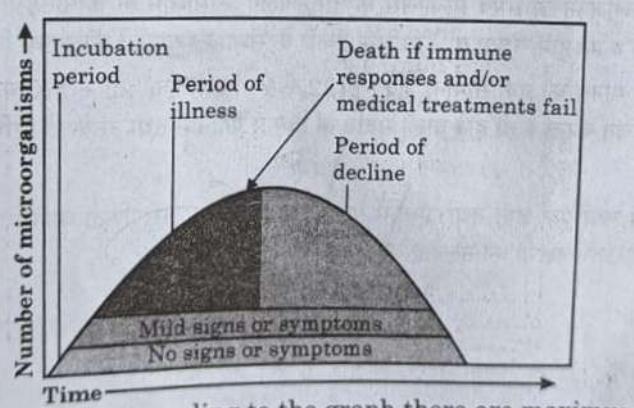
- In which period, according to the graph there are maximum chances of a person transmitting a disease/infection and why?
- Study the graph and write what is an incubation period. Name a sexually transmitted disease that can be easily transmitted during this period. Name the specific type of lymphocytes that are attacked by the pathogen of this disease.
OR
(b) Draw a schematic labelled diagram of an antibody.
(c) In which period, the number of immune cells forming antibodies will be the highest in a person suffering from pneumonia? Name the immune cells that produce antibodies.
Answer: a) Period of illness. It is because the number of disease-causing microorganisms reaches maximum in the period of illness.
b)The time between no signs and symptoms till mild signs and symptoms is called incubation period. AIDS is the sexually transmitted disease that can spread in this period. Macrophages are specific type of lymphocytes that are attacked by the pathogen of this disease.
OR
b)
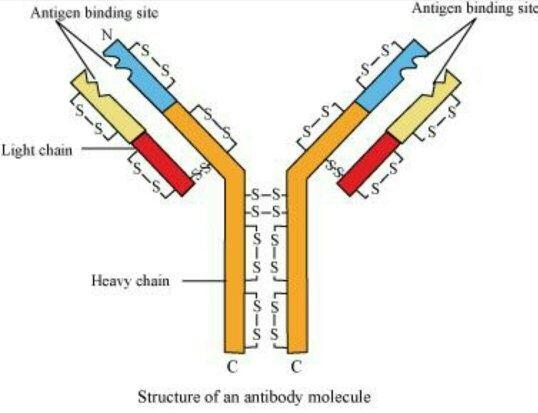
c) Period of illness.
B-lymphocytes
Question 30: The chromosome number is fixed for all normal organisms leading to species specification whereas any abnormality in the chromosome number of an organism results into abnormal individuals. For example, in humans 46 is the fixed number of chromosomes both in male and female. In male it is '44 + XY' and in female it is '44 + XX'. Thus the human male is heterogametic, in other words produces two different types of gametes one with '22 + X' chromosomes and the other with '22+ Y chromosomes respectively. Human female, on the other hand is homogametic i.e. produces only one type of gamete with '22+ X chromosomes only.
Sometimes an error may occur during meiosis of cell cycle, where the sister chromatids fail to segregate called nondisjunction, leading to the production of abnormal gametes with altered chromosome number. On fertilisation such gametes develop into abnormal individuals.
(a) State what is aneuploidy.
(b) If during spermatogenesis, the chromatids of sex chromosomes fail to segregate during meiosis, write only the different types of gametes with altered chromosome number that could possibly be produced.
(c) A normal human sperm (22+ Y) fertilises an ovum with karyotype '22 +
XX'. Name the disorder the offspring thus produced would suffer from
and write any two symptoms of the disorder.
OR
(c) Name a best known and most common autosomal aneuploid abnormality in human and write any two symptoms.
Answer: a) Aneuploidy is defined as the condition of abnormal number of chromosomes in a cell. It may occur due to extra or less number of chromosomes.
b) 22+0, 22+XY
c) Klinefelter syndrome
Symptoms:
- Males with feminine characteristics
- Decreased facial and body hair
CBSE Class 12 Biology Marking Scheme 2023
CBSE Class 12 Biology Marking scheme hasn’t been released yet.
CBSE Class 12 Biology Question Paper 2023
Download CBSE Class 12 Biology Question Paper 2023 PDF |
CBSE Class 12 Biology Marks Distribution 2023
| Title | Marks |
| Reproduction | 16 |
| Genetics and Evolution | 20 |
| Biology and Human Welfare | 12 |
| Biotechnology and its Applications | 12 |
| Ecology and Environment | 10 |
ALSO VISIT:
Comments
All Comments (0)
Join the conversation